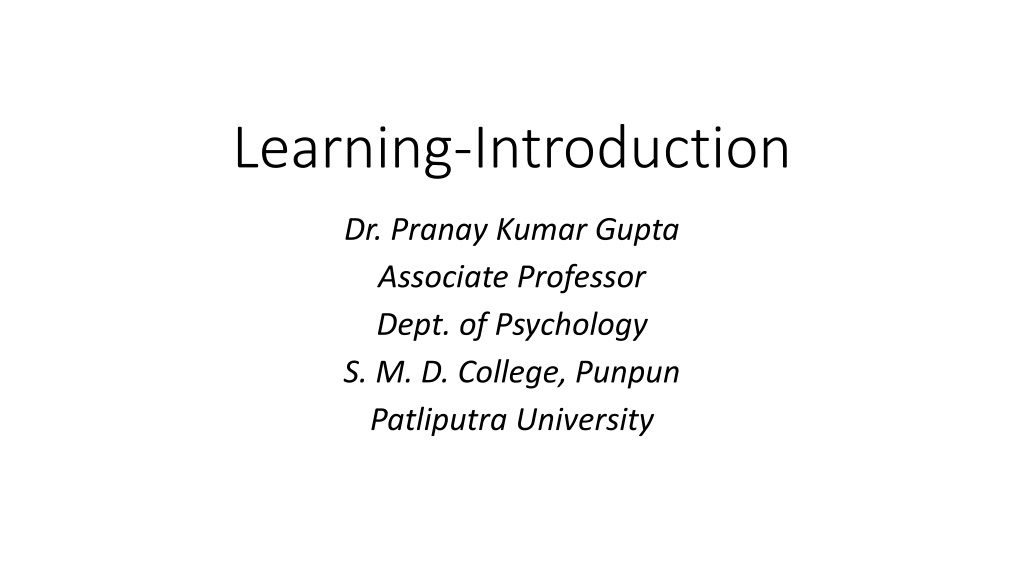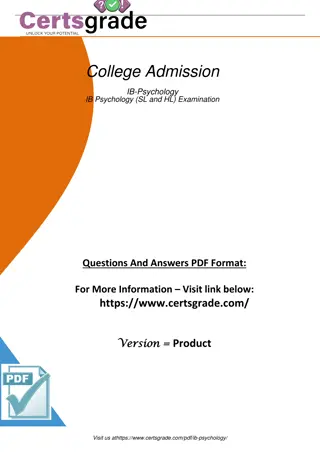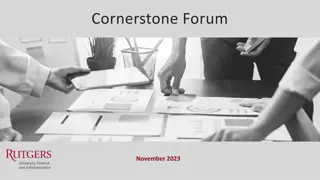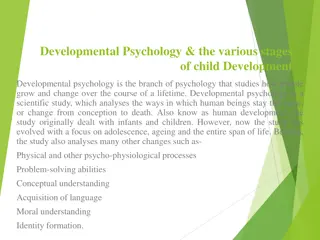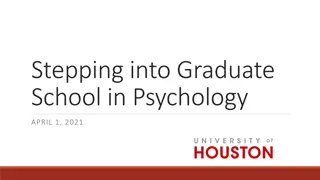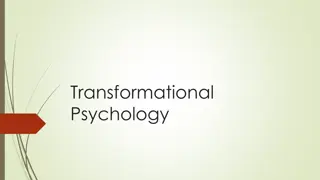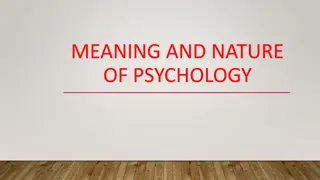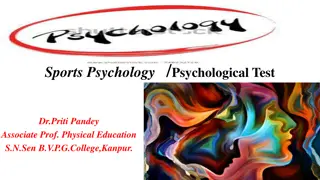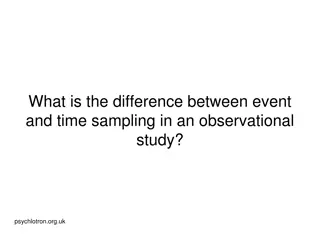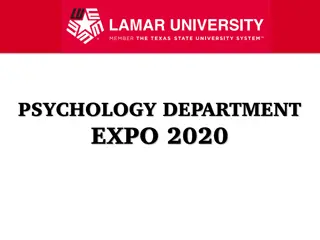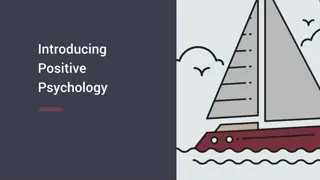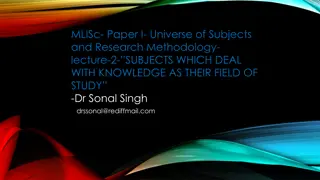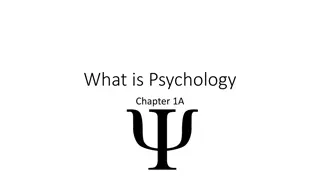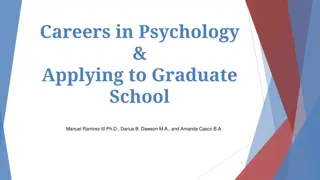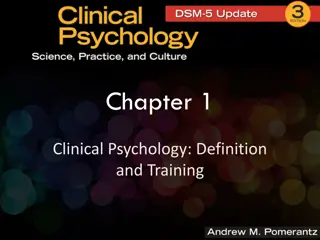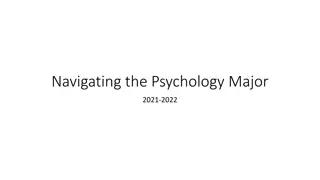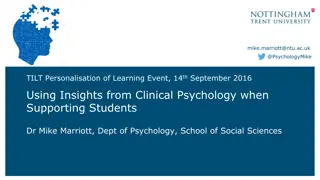Understanding Learning: The Cornerstone of Psychology
Psychology delves into the study of behavior and mental processes, with a primary focus on understanding the mental processes underlying behavior. Learning, a key mental process, leads to changes in behavior through maturation and experiences. Defined as a permanent change in behavior or potential influenced by practice and experiences, learning encompasses features such as behavioral change, permanence, and the importance of practice. Various theories of learning, including conditioning theories and observational learning, further explore the mechanisms behind how learning occurs.
Download Presentation

Please find below an Image/Link to download the presentation.
The content on the website is provided AS IS for your information and personal use only. It may not be sold, licensed, or shared on other websites without obtaining consent from the author. Download presentation by click this link. If you encounter any issues during the download, it is possible that the publisher has removed the file from their server.
E N D
Presentation Transcript
Learning-Introduction Dr. Pranay Kumar Gupta Associate Professor Dept. of Psychology S. M. D. College, Punpun Patliputra University
What is Learning? Psychology is study of behaviour and mental/cognitive processes. The major focus of psychology is to study the mental process behind the behaviour. Actually, the behaviour is the outcome or manifestation of mental process. The behaviour and mental process are the two sides of the same coin. All our mental process may be classified into three categories:- i. Cognitive Ii. Affective Iii. Conative or behavioural
Among the most important mental processes affecting the behaviour of the organisms, learning is the cornerstone. There are two main factors which produce change in behaviour. 1. Maturation- Natural unfolding of genetic potential with time. Height, capacity to talk etc. Basic prerequisite for learning. 2. Learning- Changes produced due to practice/experience.
Learning- Learning may be defined as a relatively permanent change in behaviour or behavioural potential due to practice or experience. Three necessary conditions for a process to be called as learning:- I. Change in behaviour/cognition or behavioural potential II. Relatively Permanent change III. Change produced by practice or experience.
Features of Learning:- 1. Change in behaviour:- I. There should be change in behaviour or behaviour potential. That means there should be a difference in behaviour in the pre-stage and post-stage phases. II. The difference may not necessarily lead to improvement in behaviour, it may take a change in negative direction. III.At times, the changes are not evident immediately, the change may be seen sometimes later.
Features of Learning:- 2. Relatively Permanent change:- i. To be defined as learning, the change should be permanent, ii. Though this permanence may be relative that means may vary from a few seconds to lifetime. 3. Some kind of practice or experience:- may be repeated experience such as involved in cycling, walking, and many others. Sometimes a single experience can lead to learning. Avoiding firestick, electrical wires, learned flavour aversion in animals. Changes produced by factors such as fatigue, drugs or any other intoxicants may not be considered as learning.
Theories of learning Conditioning theories Observational Learning Insight Learning Instrumental/ operant conditioning theory Classical Conditioning Theory
Classical/Respondent/Pavlovian Conditioning Theory of Learning
Proposed by a Russian Nobel Laureate Physiologist-I. P. Pavlov (1849-1936) Pavlov was conducting experiments on digestive reflexes, found out that salivary reflex could be set off by stimuli which at first were totally neutral. Pavlov had identified a fundamental associative learning process called classical conditioning. The theory is also called Respondent or Pavlovian conditioning. Classical conditioning refers to learning that occurs when a neutral stimulus (e.g., a tone)becomes associated with a stimulus (e.g., food) that naturally produces a behavior. After the association is learned, the previously neutral stimulus is sufficient to produce the behavior.
Important Terms:- The Unconditioned Stimulus (UCS) is something (such as food) that triggers a natural occurring response, and the Unconditioned Response (UR) is the naturally occurring response (such as salivation) that follows the unconditioned stimulus. The Conditioned Stimulus (CS) is a neutral stimulus that, after being repeatedly presented prior to the unconditioned stimulus, evokes a similar response (Conditioned Response) as the unconditioned stimulus.
In Pavlovs experiment, the sound of the tone/bell served as the conditioned stimulus that, after learning, produced the conditioned response (CR), which is the acquired response to the formerly neutral stimulus. Note that the UR and the CR are the same behavior in this case salivation but they are given different names because they are produced by different stimuli (the US and the CS, respectively)
Theories about Classical Conditioning 1. Stimulus Substitution:- Stimulus Substitution:- CS as a result of repeated pairing with the US, acquires the capacity to substitute for the US in evoking a response. In other words, an association-a link or a bond is formed between the CS and US so that the CS becomes the equivalent of US in eliciting a response.
According to Pavlov, this process of linking takes place in the brain. According to Pavlov, two areas of the brain, one for the CS and one for the US, became activated during the conditioning procedure and the activation of the US area resulted in a reflex, or automatic response (Cortical Irradiation).
Theories about Classical Conditioning 2. Information and expectation:- Information and expectation:- The CS becomes a signal for the US. When the CS is presented, the US is expected and the learner responds in accordance with this expectation. The learning situation in classical conditioning is one of S-S learning in which one stimulus(e.g. bell sound) becomes a signal of another stimulus (e.g. food). Here one stimulus signifies the possible occurrence of another stimulus.
Neural basis of Classical Conditioning Thompson and Krup (1994) have found that when the cerebellum of the animals are surgically destroyed, previously learned associations can be severely disrupted and the ability to learn new associations eliminated altogether. Steinmetz (1999) found that other brain structures such as hippocampus, the amygdala and the brain-stem areas that project to or receive information from the cerebellum are also involved in eye-blink conditioning.
Determinants of Classical Conditioning 1. Time relation between stimuli 2. type of the unconditioned stimulus 3. Intensity of the unconditioned stimulus
1. Time relation between stimuli-CS & US Mainly of four types based on the time relation between the onset of conditioned stimuli (CS) and unconditioned stimuli(UCS). I. Simultaneous Conditioning:- onset of CS & US are concurrent or simultaneous. Both CS & US come and go off together. II. Delayed Conditioning:- onset of CS precedes the onset of US. The CS ends before the end of the US. III. Trace Conditioning:- onset and end of the CS precedes the onset of US with some blank time between the two. IV. Backward Conditioning:-The US precedes the onset of CS.
Effectiveness of conditioning due to the temporal relation between CS & UCS Delayed conditioning procedure is the most effective way of acquiring a CR. Simultaneous and trace conditioning procedure have been found to less effective. The acquisition of response under backward conditioning procedure is very rare.
Effectiveness of conditioning due to types/nature of Unconditioned Stimulus:- i- Appetitive:-automatically elicits approach responses preparatory to their consumption such as eating, drinking, caressing and give satisfaction and pleasure. ii-Aversive:-elicits avoidance and escape responses such as noise, bitter taste, electric shock, painful injections. Note:-Appetitive classical conditioning is slower and requires greater number of acquisition trials than the aversive conditioning.
Effectiveness of conditioning due to Intensity of the Conditioned stimuli:- More intense conditioned stimuli are more effective in accelerating the acquisition of conditioned responses that means require fewer number of acquisition trials.
Phenomenon in Classical Conditioning:- Acquisition:- A gradual process by which a conditioned stimulus acquires the ability to elicit a conditioned response through repeated pairings of an unconditioned stimulus. Repeated pairing of bell and food causes acquisition. Generalization:- The tendency of the stimuli similar to a conditioned stimulus to evoke a conditioned response. Sound of buzzer or other tone similar in nature may evoke a conditioned response of salivation.
Discrimination:- The process by which organisms learn to respond to certain stimuli but not to others. The dog may not salivate upon the sound of a very dissimilar nature or to a light not conditioned earlier. Reconditioning:- If the conditioned stimulus(the bell) and the unconditioned stimulus (the meat powder) are again paired after the conditioned response of salivation has been extinguished, salivation will return very quickly- a process termed as reconditioning.
Phenomenon in Classical Conditioning:- Extinction:-The process by which a conditioned stimulus gradually loses the ability to evoke conditioned responses when it is no longer followed by the unconditioned stimulus. In other words, extinction is the eventual decline and disappearance of a conditioned response (salivation) in the absence of an unconditioned stimulus (food). Spontaneous Recovery:-The reappearance of the reaction (conditioned response) after a time interval is referred to as spontaneous recovery.
Applications of Classical Conditioning Flooding: Exposed to the harmless stimulus until fear is extinguished. Systematic Desensitization: Relaxation techniques designed to gradually expose you to whatever stimulus you fear while keeping you very relaxed Counterconditioning: Pairing a pleasant stimulus repeatedly with a fearful one ((ice cream and spiders) Bell-and-Pad method in the treatment of bed-wetting (Nocturnal enuresis):- Technique used to help kids who have a problem with bed wetting pad has an alarm that sounds with even a drop of urine conditions the child to get up and use the restroom
MCQ:-No.1 1. Pavlov is famous for his work in: a. contingent conditioning b. operant conditioning c. classical conditioning d. oppositional conditioning
MCQ:-No.2 In classical conditioning, US stands for: a. unintentional stimulus b. unconditioned stimulus c. unconnected stimulus d. none of the above
MCQ:-No.3 In classical conditioning, UR and CR are: a. opposite behaviours b. the same behaviour c. the result of extinction d. the same stimulus
MCQ:-No.4 People who have a lot of dental problems often come to dislike even the smell of their dentist s office. The smell represents a(n): a. US b. UR c. CS d. CR
MCQ:-No.5 Which of these is an unconditioned stimulus? Shock Food Loud Noise Pain None of these All of these
MCQ:-No.6 Which of these is an unconditioned response? Sweating Startle response Salivation Blink None of the above All of the above
